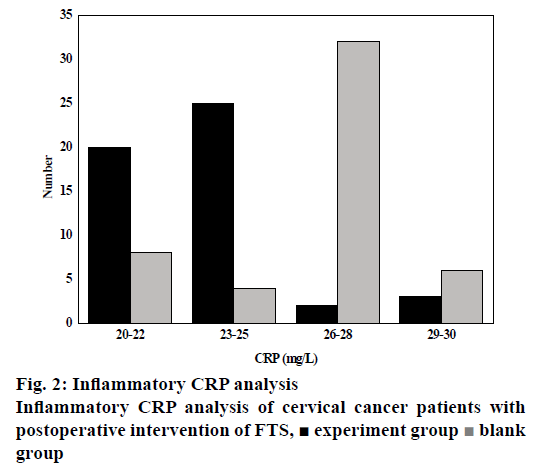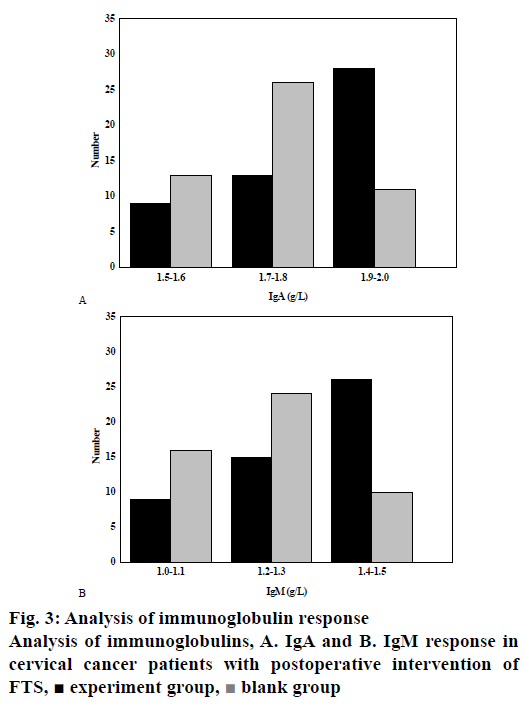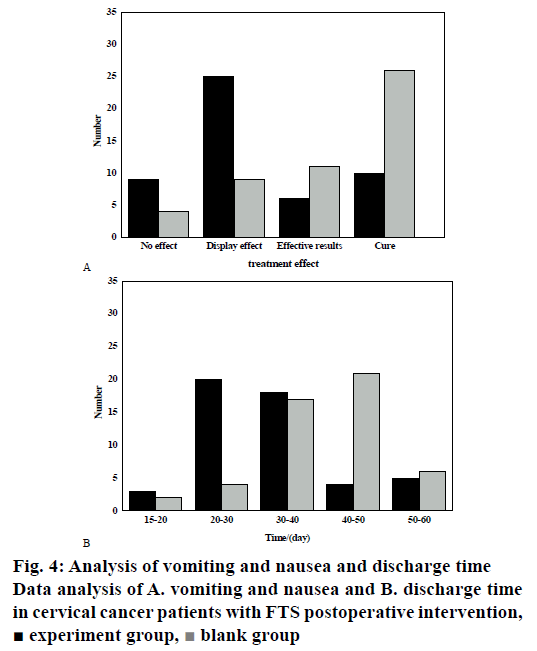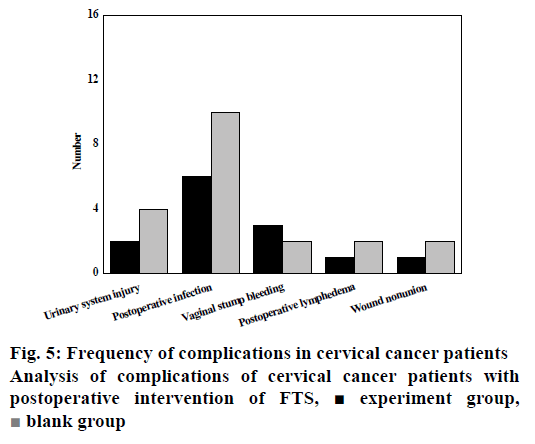- *Corresponding Author:
- H. Liao
Department of Central Sterile Supply, The Third Affiliated Hospital of Southern Medical University, Guangzhou City, Guangdong Province, China
E-mail: liaohuidi3yy@126.com
| This article was originally published in a special issue, "Clinical and Experimental Studies on Drug and Intervention Repurposing in China |
| Indian J Pharm Sci 2019:81(4)spl issue1;73-78 |
This is an open access article distributed under the terms of the Creative Commons Attribution-NonCommercial-ShareAlike 3.0 License, which allows others to remix, tweak, and build upon the work non-commercially, as long as the author is credited and the new creations are licensed under the identical terms
Abstract
The purpose of this research was to study the effect of fast-track surgery model under nursing intervention on postoperative rehabilitation of patients with early cervical cancer. In this research, patients with cervical cancer were taken as the research objects. Based on the fast-track surgery model, the nursing intervention was carried out for the postoperative diet time, activity time of getting out of bed, drainage tube placement, pain relief, nausea, vomiting, complications, immunity. The results showed that postoperative nursing and rehabilitation intervention based on fast-track surgery model had a significant effect on postoperative rehabilitation of early cervical cancer patients. Compared with the blank group, the immune status and complications were significantly improved, and other indicators were developing in a positive direction. In summary, postoperative nursing and rehabilitation intervention based on fast-track surgery model had a positive impact on postoperative recovery of early cervical cancer patients, which could improve diet, shorten hospital stay, and had good clinical application. There are still some shortcomings in the research process, but the research results still provide some guidance for future research. Therefore, it is a research topic with practical significance.
Keywords
FTS, nursing, cervical cancer, immunity
Fast-track surgery (FTS) is a new concept of surgical treatment in medicine proposed in recent years[1]. It mainly improves and combines relevant perioperative measures, procedures and operations according to the evidence-based medical evidence, so as to minimize the stress response during surgery, to improve the recovery, to reduce the possibility of surgical complications for better prognosis of surgical patients[2]. FTS is also known as a measure to promote postoperative rehabilitation[3,4]. As a new surgical treatment, FTS can significantly improve the postoperative rehabilitation of patients and shorten the time required for hospitalization, so as to optimize the allocation of integrated medical resources[5].
The FTS integrates measures of evidence-based medical practices during the perioperative period and combines the latest research evidence from multiple disciplines[6-8]. It emphasizes the reduction of all kinds of stress in perioperative period, so as to promote the recovery of all organ functions after surgery, reduce various complications in perioperative period, and shorten the hospital stays of patients[9,10]. It is the result of the combination of multiple measures and the coordination of multiple disciplines, such as more humanistic psychological counseling and preoperative preparation, the implementation of minimally invasive surgery, the coordination of nurses in surgery, anesthesiology department and anesthesiology, postoperative analgesia, no placement or early removal of drainage tube and so on[11,12]. FTS concept was first applied in lung cancer surgery[13-15]. Currently, it is most widely used in general surgery, where relatively mature experience was gained[16,17]. FTS concept has universal guiding significance for perioperative treatment of various surgical specialties[18,19]. Therefore, at present, this concept has been gradually extended to hepatobiliary surgery, urology surgery, cardiothoracic surgery, and craniocerebral surgery[20,21]. In the field of gynecology, the application of this concept is still limited. Although there are experiences in other fields to be used for reference, various perioperative measures suitable for gynecological surgery are still in exploration stage[22,23].
To sum up, in this study, the effect of information intervention on cervical cancer patients was analysed by studying the postoperative complications, immune cell status in vivo and physical feelings of cervical cancer patients. It is hoped that the results of this study can provide some guidance for future research.
Materials and Methods
Subjects and exclusion criteria:
From January 2015 to October 2018, 100 patients aged 29-50 y who underwent extensive laparoscopic hysterectomy and pelvic lymph node dissection in the Third Affiliated Hospital of Southern Medical University due to cervical cancer (stage 1a2-1la) were selected. This study has obtained the consent of the hospital ethics committee, and the patients and their families were briefed by a special person before being enrolled in the study. The signed informed consent was obtained.
Patients who received neoadjuvant chemotherapy before surgery; patients with abnormal liver and kidney function or hypoproteinemia; patients with a history of autoimmune diseases, nephritis, hypertension, diabetes, cardiovascular diseases, and cerebrovascular diseases; patients with severe organ dysfunction; patients who have undergone open surgery; and patients with abnormal immune function and stress response were excluded. Patients were randomly divided into two groups according to the random comparison table: FTS group and control group, with 50 cases in each group.
Postoperative intervention nursing of FTS:
The control of postoperative nausea and vomiting reaction is very important. Some of the major concerns of patients who choose to receive anesthesia before surgery are postoperative nausea and vomiting. The rehabilitation concept of FTS requires preventive treatment in advance for patients with medium and high risk coefficients. In this study, the FTS risk assessment model uses Apfel to assess risk factors. Apfel is mainly based on the following four aspects, female, smoking cessation, prehistory of postoperative nausea, vomiting or carsickness, and expected use of opioids after surgery. If there are more than three risk factors, it is necessary to inject dexamethasone intravenously after anesthesia or to inject 5-HT3 antagonist intravenously at the end of surgery. For patients with Apfel risk assessment scores of 3 and 4, it is strongly recommended to strengthen the prevention of POIIV. In addition, general intravenous anesthesia with propofol anesthesia may also be used to prevent vomiting.
Postoperative drainage tube; FTS concept believes that currently there are not enough studies to prove that drainage tube can prevent fistula. On the contrary, placing drainage tube after surgery brings great pressure to the patient’s mind and hurt the body at the same time. Based on this, many patients delay getting out of bed for activities, and the drainage tube may bring trouble of retrogressive infection, thus increasing the adverse stress in perioperative period, as shown in fig. 1, which has a great negative effect on postoperative recovery of patients. Therefore, FTS concept suggests that drainage tube should not be used in surgery, especially in abdominal surgery. Since the peritoneum has a very strong absorption capacity, the drainage tube is not required, which is also suitable for the catheter, because the role and function of the catheter and the drainage tube are similar. Therefore, the concept of FTS is more advanced than common concepts, and patients' unnecessary long-term use of this tool can be avoided.
As generally known, the main immune mechanism of the body to fight cancer is cellular immunity. Therefore, the cellular immunity directly indicates the ability of the human body to resist tumor, and it is extremely important to prevent the destruction of the cellular immunity mechanism after surgery for the postoperative rehabilitation of patients with cervical cancer. Studies have shown that postoperative cellular immunity of patients in FTS group is significantly better than in the blank group[24-26]. Although the postoperative IgM value of the FTS group was higher than that of the blank group, there was no significant difference in postoperative IgA and IgG between the 2 groups. On one hand, it is related to the sample size, and on the other hand, it is related to the long halflife of IgG. The levels of IgG in the blood does not indicate the immune status of the body. Based on the FTS concept, it is very important to determine whether patients can recover normally and how their immune system works after surgery. Immune cells are the most important weapon against tumor cells, so it is the most important job for the immune system to recover as soon as possible after surgery. Without the normal work of the immune system, the patient's body can’t recover normally. The most important thing for the recovery of the immune system is the normal reproduction of immune cells. The concept of FTS emphasizes that the production and work of immune cells should be restored as soon as possible after surgery, and immune cells are the core and the most important part of the immune system.
The idea of FTS ensures that early postoperative diet not cause other complications, but can reduce the risk of postoperative infection, promote the recovery of patients as soon as possible, and do not take the appearance of hunger sounds as a sign to eat. Studies have shown that eating early after surgery has no other problems, which can not only promote gastrointestinal motility, but also slow down the hypoglycemia and hunger caused by the prohibition of diet before surgery[27,28]. For the number of postoperative meals, patients can decide it according to their own situation, and they can have more meals a day but less food each time, from complete liquid diet to semi-liquid diet and then to normal diet. In this study, eating in the early postoperative period did not cause abdominal distention, nausea or vomiting. In addition, diet at the early stage after surgery can provide energy for the recovery of patient in time, as shown in fig. 2. In practical conditions, patients can start to drink boiled water or sugar water under the supervision of nurses 8 h after the operation.
FTS requires patients not to stay in bed for a long time after surgery. Long period of inactivity weakens the function of lungs and causes muscle contraction, which increases the risk of venous thrombosis. FTS believes that patients should be allowed to exercise as much as possible after surgery, which can not only improve the lung function, but also improve the oxygen supply of tissues and reduce the risk of venous thrombosis. The premise of early postoperative activity is effective pain relief. In this respect, the principle of gradual sequence should be followed. Patients in the FTS group can start their activities within 8 h after surgery. They must be supervised by nurses in the first 2 d and the time should be at least half an hour. This intensity of activity does not cause significant strain and fatigue to the patient's body, nor does it leave the patient in a static state. But there must be a caregiver to help the patient to avoid unexpected situations, because the patient's postoperative body is still weak and malnourished. With the passage of time, the patient's activity time and geographical scope can be gradually increased, and finally the patient's independent rehabilitation exercise can be realized.
In this study, postoperative complications were classified into 5 levels according to FTS. Level 0-1- minor condition that didn’t require treatment; level 2- it required medication-assisted rehabilitation; level 3- complications after long-term illness or organ resection; level 4- life-threatening complications requiring ICU; level 5- death caused by complications. Complications of level 2-5 were recorded, excluding postoperative urinary retention. Postoperative complications are the biggest obstacle to the recovery of patients with cervical cancer. If the postoperative symptoms can be well controlled or even without postoperative complications, it is conducive for patients' speedy recovery. Therefore, standard intervention of complications based on FTS concept is a great help for patients' postoperative recovery and treatment.
Seventh, discharge standard. FTS concept believes that patients can be discharged when their body temperature remains normal, they can eat normally, without obvious pain, abdominal distension, nausea and other discomfort, the drainage tube is removed, and routine blood tests show no abnormalities. If the patients meet the above conditions, they can also leave the hospital with a catheter. After leaving the hospital, the patients must go to the hospital regularly for reexamination and test, and the catheter should be removed or replaced according to the patient's situation. Therefore, compared with common concepts, the standard of postoperative discharge intervention based on the FTS concept is more advanced. Unnecessary hospitalization imposes a heavy financial burden on the family, so patients should be discharged when all indicators return to normal. A good family environment and care of loved ones is of great help to patients in physical and psychological aspects, especially at the psychological level, which can’t be obtained in the hospital. Confidence and state recovery at the psychological level are the basis and core of recovery.
Results and Discussion
Comparison results of exhaust time of cervical cancer patients with postoperative intervention of FTS are shown in fig. 1. It can be observed from the figure that the exhaust time of cervical cancer patients in the FTS postoperative intervention group was mainly between 20-25 and 26-30, while that of patients in the blank control group was mainly between 31-35 and 36-40. As the patients in the 2 groups were randomly assigned before the start of the experiment, it can be concluded that the postoperative nursing intervention based on the FTS model had a good recovery effect on the patients with cervical cancer, thus fully verifying the improvement effect of the postoperative nursing intervention based on the FTS model on the exhaust of cervical cancer patients.
Inflammatory CRP analysis of cervical cancer patients with postoperative intervention of FTS is shown in fig. 2. It can be observed from the figure that the inflammatory CRP of patients in the experimental group was mainly concentrated between 20-22 and 23-25, while the inflammatory CRP of patients in the blank control group was mainly concentrated between 26-28 and 20-22. As the patients in the two groups were randomly assigned before the start of the experiment, it can be concluded that the postoperative nursing intervention based on the FTS model had a significant effect on the patients with cervical cancer, which further fully verified that the postoperative nursing intervention based on the FTS model had a good effect on inflammatory CRP.
Analysis of immunoglobulin IgA response in cervical cancer patients with postoperative intervention of FTS is shown in fig. 3A. It can be observed from the figure that the immunoglobulin IgA of patients in the experimental group was mainly concentrated in the range of 1.9-2.0 and 1.7-1.8, while the immunoglobulin IgA of patients in the blank control group was mainly concentrated in the range of 1.5-1.6. Since the patients in the 2 groups were randomly grouped before the start of the experiment, it can be concluded that the postoperative nursing intervention based on FTS model had a good recovery effect on immunoglobulin IgA of cervical cancer patients.
Analysis results of IgM response of immunoglobulin in cervical cancer patients with postoperative intervention of FTS is shown in fig. 3B. It can be observed from the figure that the immunoglobulin IgM of patients in the experimental group was mainly concentrated between 1.4-1.5 and 1.2-1.3, while the immunoglobulin IgM of patients in the blank control group was mainly concentrated between 1.2-1.3. As the patients in the two groups were randomly assigned before the start of the experiment, it can be concluded that postoperative nursing intervention based on FTS model had a good recovery effect on immunoglobulin IgM in patients with cervical cancer.
Data analysis of vomiting and nausea in cervical cancer patients with FTS postoperative intervention is shown in fig. 4A. It can be observed from the figure that the data of vomiting and nausea in the experimental group was mainly focused on the effective and cured effects, while the data of vomiting and nausea in the blank control group were mainly focused on the ineffective and demonstrative effects. As the patients in the two groups were randomly assigned before the start of the experiment, it can be concluded that postoperative nursing intervention based on the FTS model had a good effect on the cure of vomiting and nausea in patients with cervical cancer.
Data analysis results of discharge time of cervical cancer patients with postoperative intervention of FTS are shown in fig. 4B. It can be observed from the figure that the discharge time of patients in the experimental group was mainly between 20 and 40 d, while the discharge time of patients in the blank control group was mainly between 30 and 50 d. As the patients in the 2 groups were randomly assigned before the start of the experiment, it can be concluded that the postoperative nursing intervention based on the FTS model had a good effect on the control of the discharge time of patients with cervical cancer.
Analysis and statistics results of complications of cervical cancer patients with postoperative intervention of FTS are shown in fig. 5. As can be observed from the figure, the complications data of patients in the experimental group were mainly concentrated in about 10 patients, and the complications data of patients in the blank control group was mainly concentrated in about 30 patients. As the patients in the 2 groups were randomly assigned before the start of the experiment, it can be concluded that postoperative nursing intervention based on the FTS model had a good effect on the control of complications in patients with cervical cancer.
In this experiment, in the case of FTS intervention, the changes of various postoperative physical indicators of cervical cancer patients, such as nausea, vomiting, pain relief, activity time of getting out of bed, diet time, drainage tube placement and other aspects, were analyzed in detail, so as to study the effectiveness of FTS intervention in the recovery of cervical cancer patients. The results showed that the postoperative nursing intervention based on FTS had a significant effect on the recovery of cervical cancer patients. Compared with the blank group, patients in the experimental group showed significant improvement in the recovery of most indicators. Besides, patients were improved in both physical and intellectual aspects. Therefore, information intervention can be promoted in clinical aspects. There are still some shortcomings in this study, such as the insufficient number of samples in the experiment and the different physical qualities of each patient. However, the research results still provide some guidance for future continuous research, so it is a research topic with practical significance.
References
- Nagajyothi PC, Muthuraman P, Sreekanth TVM, Kim DH, Shim J. Green synthesis: In-vitro anticancer activity of copper oxide nanoparticles against human cervical carcinoma cells. Arab J Chem 2017;10(2): 215-25.
- Pandurangan M, Enkhtaivan G, Kim DH. Anticancer studies of synthesized ZnO nanoparticles against human cervical carcinoma cells. J Photochem Photobiol 2016;158:206-11.
- Cheng K, Hao M. Metformin inhibits TGF-β1-induced epithelial-to-mesenchymal transition via PKM2 relative-mTOR/p70s6k signaling pathway in cervical carcinoma cells. Int J Mol Sci 2016;17(12):2000.
- Pandurangan M, Enkhtaivan G, Venkitasamy B, Mistry B, Noorzai R, Jin BY, et al. Time and concentration-dependent therapeutic potential of silver nanoparticles in cervical carcinoma cells. Biol Trace Elem Res 2016;170(2):309-19.
- Qin X, Wan Y, Wang S, Xue M. MicroRNA-125a-5p modulates human cervical carcinoma proliferation and migration by targeting ABL2. Drug Des Dev Ther 2016;10:71.
- Zhang X, Cai D, Meng L, Wang B. MicroRNA-124 inhibits proliferation, invasion, migration and epithelial-mesenchymal transition of cervical carcinoma cells by targeting astrocyte-elevated gene-1. Oncol Rep 2016;36(4): 2321-8.
- Huang L, Huang Z, Fan Y, He L, Ye M, Shi K. FOXC1 promotes proliferation and epithelial-mesenchymal transition in cervical carcinoma through the PI3K-AKT signal pathway. Am J Transl Res 2017;9(3):1297.
- Chang WC, Li CH, Chu LH, Huang PS, Sheu BC, Huang SC. Regulatory T cells suppress natural killer cell immunity in patients with human cervical carcinoma. Int J Gynecol Cancer 2016;26(1):156-62.
- Chen H, Wang J, Yang 1, Chen D, Li P. Association between FOXM1 and hedgehog signaling pathway in human cervical carcinoma by tissue microarray analysis. Oncol Lett 2016;12(4):2664-73.
- Xu H, Wang Z, Xu L, Mo G, Duan G, Wang Y, et al. Targeting the eIF4E/β-catenin axis sensitizes cervical carcinoma squamous cells to chemotherapy. Am J Transl Res 2017;9(3):1203.
- Pandurangan M, Enkhtaivan G, Kim DH. Cytotoxic effects of aspartame on human cervical carcinoma cells. J Toxicol Pharmacol 2016;5(1):45-52.
- Lee DY, Chong C, Lee M, Kim JW, Park NH, Song YS, et al. Prognostic factors in neuroendocrine cervical carcinoma. Obstet Gynecol 2016;59(2):116-22.
- Pandurangan M, Enkhtaivan G, Young JA, Hoon HJ, Lee H, Lee S, et al. In vitro therapeutic potential of TiO 2 nanoparticles against human cervical carcinoma cells. Biol Trace Elem Res 2016;171(2):293-300.
- Yue Q, Feng L, Cao B, Liu M, Zhang D, Wu W, et al. Proteomic analysis revealed the important role of vimentin in human cervical carcinoma HeLa cells treated with gambogic acid. Mol Cell Proteom 2016;15(1):26-44.
- Li J, Huang J, Zhang J, Li Y. A home-based, nurse-led health program for postoperative patients with early-stage cervical cancer: a randomized controlled trial. Eur J Oncol Nurs 2016;21:174-80.
- Xie C. Effect of comprehensive intervention on recovery of gastrointestinal function in patients with renal cancer after operation. World Chin J Digestol 2015;23(14):2328.
- Alimohammadi N, Maleki B, Shahriari M, Chitsaz A. Effect of a care plan based on roy adaptation model biological dimension on stroke patients' physiologic adaptation level. Iran J Nurs Midwifery Res 2015;20(2):275-81.
- Del Pizzo JJ, Jacobs SC, Bartlett ST, Sklar GN. Urological complications of bladder‐drained pancreatic allografts. Br J Urol 2015;81(4):543-7.
- Nawaytou HM, Peyvandi S, Brook MM, Silverman N, Moon-Grady AJ. Right ventricular systolic-to-diastolic time index: hypoplastic left heart fetuses differ significantly from normal fetuses. J Am Soc Echocardiogr 2016;29(2):143-9.
- Christiansen CL, Bade MJ, Davidson BS, Dayton MR, Stevenslapsley JE. Effects of weight-bearing biofeedback training on functional movement patterns following total knee arthroplasty: a randomized controlled trial. J Orthop Sports Phys Ther 2015;45(9):647.
- Bond KT, Frye V, Taylor R, Williams K, Bonner S, Lucy D. Knowing is not enough: a qualitative report on hiv testing among heterosexual african-american men. AIDS Care 2015;27(2):182-8.
- Jung H, Yamasaki M. Association of lower extremity range of motion and muscle strength with physical performance of community-dwelling older women. J Physiol Anthropol 2016;35(1):30.
- Ling Y, Zhao X, Li X, Wang X, Yang Y, Wang Z. Novel fts-diamine/cinnamic acid hybrids inhibit tumor cell proliferation and migration and promote apoptosis via blocking ras-related signaling in vitro. Cancer Chemother Pharmacol 2015;75(2):381-92.
- Young HJ, Mehta TS, Herman C, Wang F, Rimmer JH. The effects of movement-to-music (m2m) and adapted yoga on physical and psychosocial outcomes in people with multiple sclerosis. Trials 2018;19(1):394.
- Crockett NJ, Sandrey MA. Effect of prophylactic ankle-brace use during a high school competitive basketball season on dynamic postural control. J Sport Rehabil 2015;24(3):252-60.
- Lee JE, Son JW. Two teacher educators' approaches to developing preservice teachers' mathematics assessment literacy: intentions, outcomes, and new learning. Teaching and Learning Inquiry: The ISSOTL Journal, 2015;3(1):47-62.
- Gao LY, Ma QF, Zhang Y. Effect of self care on stoma changes and postoperative quality of life in patients after colostomy for rectal cancer. World Chin J Digestol 2017;25(7):638.
- Pengzhi Z. The comprehensive nursing intervention effects on postoperative complications of spinal surgery patients. Acta Bioch Bioph Sin 2015;24(3):301-2.
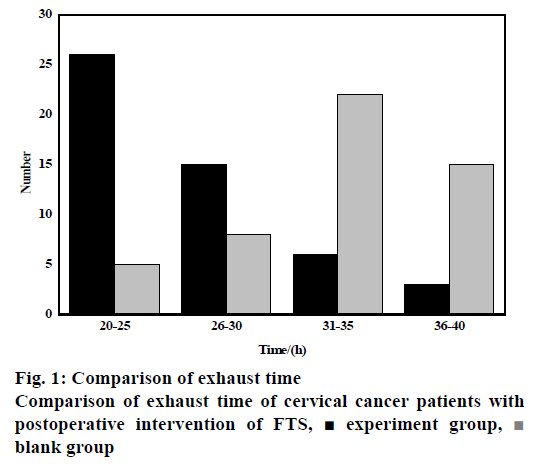
 experiment group,
experiment group,  blank group
blank group